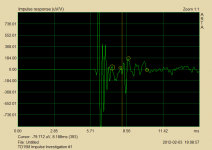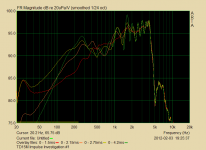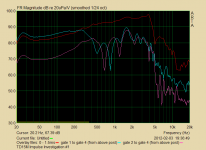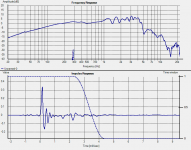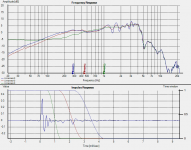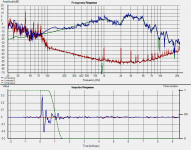Okay, here comes some data. This post: impulse, with frequency responses at various gate times. The key on the freq. response plots also corresponds to the circles on the impulse response. The peak before each gate time is one that makes a significant difference. I only included new gates and responses for the peaks that make a significant difference in response. Time zero referenced on the response plots is the start of the impulse, not the time zero shown on the impulse. The next post will show time windows after the start of the impulse, as requested.
Between gates 1 and 2 in the impulse is the blip that is not a consistent feature. It is something with my cabinets that I should be able to fix.
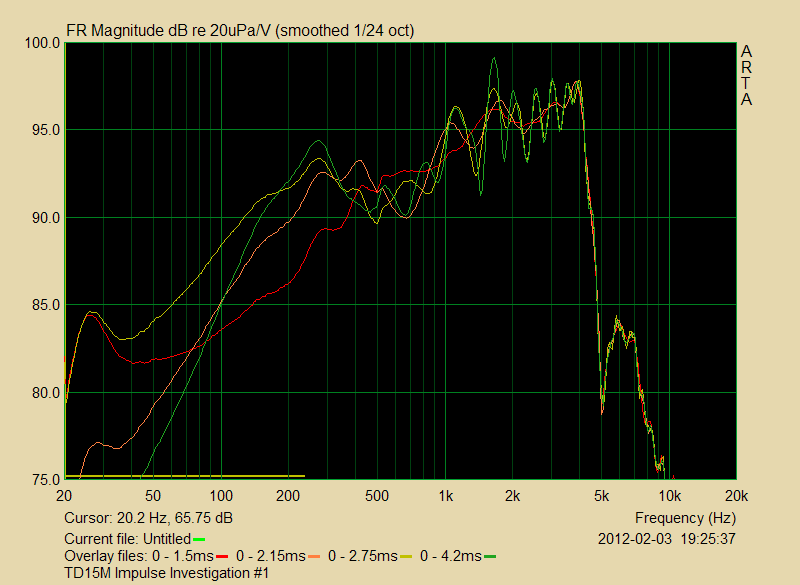
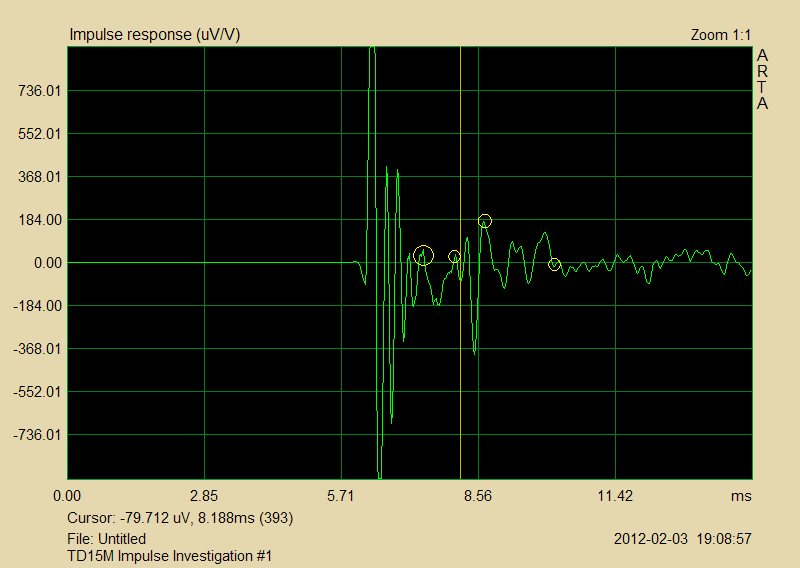
Between gates 1 and 2 in the impulse is the blip that is not a consistent feature. It is something with my cabinets that I should be able to fix.
Attachments
Last edited:
Here are two responses from time windows restricted to the area of interest. Sorry I had to change the magnitude scale from above. All gates are uniform here and above, btw - no hanning taper. The pink one (I think) is the real subject here, while the blue one includes the cabinet-related thing I should be able to figure out on my own.
I hope you can interpret how this refers to the previous post - it is hard to make this easy to follow!
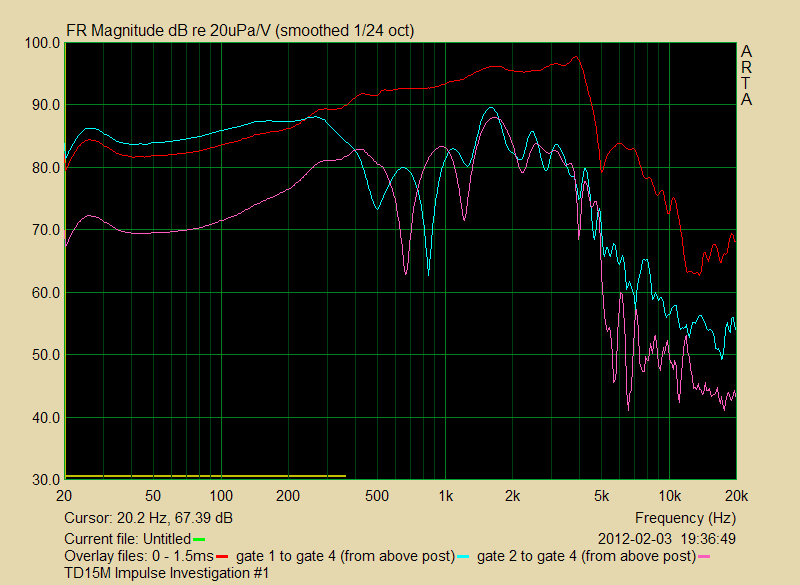
I hope you can interpret how this refers to the previous post - it is hard to make this easy to follow!
Attachments
Last edited:
I'm not sure I understand what you're saying - you realize the 2.45ms cannot be any normal reflection, right? If you're saying there's too much other stuff going on to examine the 2.45ms issue, I may need to use a measurement without the 1.7-2.0ms reflection instead of just trying to start the gate after it. I'll give that a try next.It looks like reflections are getting in once the gate moves past about 2.5ms, as the question about the 2.45ms issue would suggest?? Are you sure you're reflection free more than 1m in all directions?
Thanks for updating Keto. If you can give me enough details I can try to replicate that. Looks similar to what I'd get with averaged periodic noise, I think.
I'm not having much luck with eliminating the other anomaly above so far. I removed the back of the cabinet, put fiberglass all over the place, and wrapped cork around baffle edges (because that has an effect on the DE250 being tested in the same enclosure). No noticeable change in the impulse, and nothing but fractions of a decibel here and there in the freq. response. So, I figured maybe I'll go back to the other woofer in free air, but that immediately seemed silly - too many other issues to deal with. Not sure what I'll try next. Maybe this is all the same issue as the 2.45ms thing.
I'm not having much luck with eliminating the other anomaly above so far. I removed the back of the cabinet, put fiberglass all over the place, and wrapped cork around baffle edges (because that has an effect on the DE250 being tested in the same enclosure). No noticeable change in the impulse, and nothing but fractions of a decibel here and there in the freq. response. So, I figured maybe I'll go back to the other woofer in free air, but that immediately seemed silly - too many other issues to deal with. Not sure what I'll try next. Maybe this is all the same issue as the 2.45ms thing.
Last edited:
That's at about a foot from the baffle -- if I get any further out the room starts participating too much. The baffle is 18"-wide by 17"-high. And mine are 10 year-old Apollos, with the short "nose-cones". I've been doing measurements with different amps, and the single-ended triode amps seem to produce better results than the solid-state options I've got here. Take all this with a grain of salt, since I've been measuring for all of 2 days, now. If the weather ever clears, I'll do some outdoor measurements.
I'm not so sure it's the room at any point, though... If I measure nearfield, I don't get anything that affects response much at all beyond the 2.45ms thing. It's around 1.6-2.5ms where I get what looks like a reflection, but doesn't seem to be (I think we've established that exists above) and I'm not sure there's much else.
I thought there was something else to eliminate before 2ms, but now I'm not so sure about that because I can't do anything that reveals a separate effect from what happens most dramatically at 2.45.
Here's a measurement in HOLMImpulse, for a different look at the same thing (it decided to call the main issue 2.25ms). I'm not sure why HOLM is giving me this junk before the impulse right now, but arta is not and gives the exact same response (if the same gate is set), so I wouldn't worry about that.
I thought there was something else to eliminate before 2ms, but now I'm not so sure about that because I can't do anything that reveals a separate effect from what happens most dramatically at 2.45.
Here's a measurement in HOLMImpulse, for a different look at the same thing (it decided to call the main issue 2.25ms). I'm not sure why HOLM is giving me this junk before the impulse right now, but arta is not and gives the exact same response (if the same gate is set), so I wouldn't worry about that.
Attachments
Last edited:
No, because it appears with no baffle too. The 2.45ms thing, as I have been calling it, cannot be any sort of diffraction/reflection unless it comes directly from the woofer. The discussion linked above concludes that it's multiple resonances. The questions now, as best as I understand, are:could it be a baffle edge diffraction effect?
1. Is there anything else in these measurements that should be dealt with? Or, can we even tell?
2. What the heck part of this data should I use to sim/design my crossover? (see gating comparisons above, although I'll have to go back to measuring from farther away).
3. Is it remotely possible to do anything about this in the crossover? I'm just not sure how to figure that out. I think I understand that if I use a hard cutoff gate to isolate it in the impulse, that would direct me, but ARTA won't let me gate so few samples, and HOLM seems to only do hanning tapers, so I guess I need a third software option to do that.
Just curious keto, does this curve repeat at lower levels? That looks like your possibly at the voltage limit of the mic where it's very flat at 125 dB SPL.
Hi dumptruck;
I remember you stating that this does not show up on any of your other speakers but I am still wondering:
Could you post a measurement of another driver for comparison taken under the same conditions and set-up? Further out in time I see some more noise in the line, if you perform a sweep with no driver what does the line look like? I'm curious what the noise floor level is.
Do you have the stuff to perform a high resolution impedance sweep? If so does the issue of concern show up there?
What are you driving the speaker with? A power amp or a chip? I just wonder if dampening offers any control over it.
Hey, I don't know if this is exactly what you're looking for, but here is a shot taken at 9" in a 2 cu ft box and driven by a SET amp, with and without filtering.
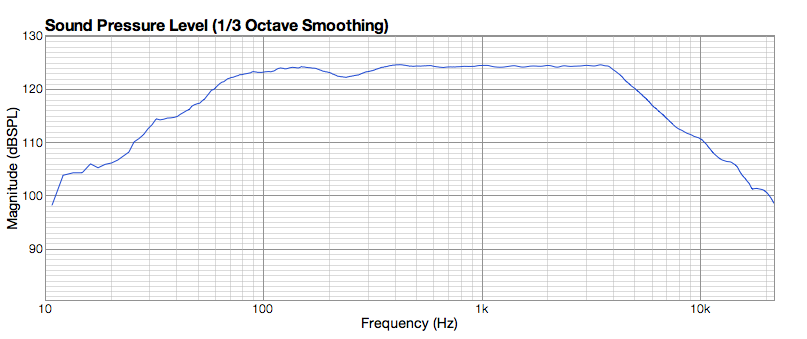
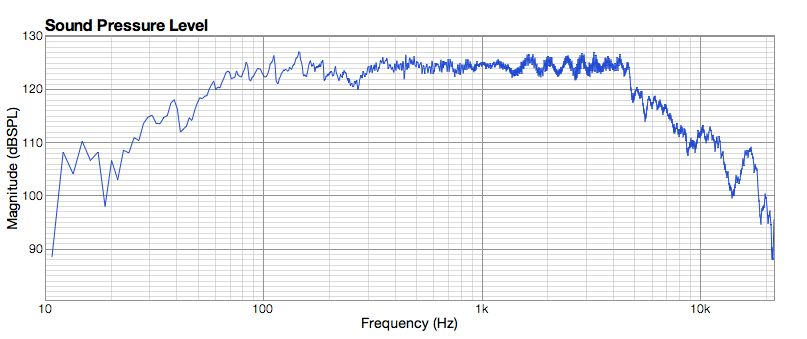
Hi dumptruck;
I remember you stating that this does not show up on any of your other speakers but I am still wondering:
Could you post a measurement of another driver for comparison taken under the same conditions and set-up? Further out in time I see some more noise in the line, if you perform a sweep with no driver what does the line look like? I'm curious what the noise floor level is.
Do you have the stuff to perform a high resolution impedance sweep? If so does the issue of concern show up there?
What are you driving the speaker with? A power amp or a chip? I just wonder if dampening offers any control over it.
Sure, I'll do it in a minute here.Could you post a measurement of another driver for comparison taken under the same conditions and set-up?
That longest gate shown above has almost the exact same frequency response as completely ungated. I'll see if I can't get you a no-driver measurement.Further out in time I see some more noise in the line, if you perform a sweep with no driver what does the line look like? I'm curious what the noise floor level is.
No, but I am getting something very soon. Here is someone else's sweep of the 8 ohm version in zma format: http://libinst.com/junk/TD15M SEOS15/Woofer.zmaDo you have the stuff to perform a high resolution impedance sweep? If so does the issue of concern show up there?
Right now, the amp section of a concept 5.5 receiver, but I was using other amps before. I have not used anything with high output impedance.What are you driving the speaker with? A power amp or a chip? I just wonder if dampening offers any control over it.
1audiohack's requested sanity check attached. Measurement is not of the driver being discussed, but rather a Weber Signature 10" ceramic guitar driver.
red = measurement of room. No, I do not know what's going in the bass, but obviously that isn't real.
blue = driver, ungated, log sweep starting at 100Hz
green = driver with gate shown
red = measurement of room. No, I do not know what's going in the bass, but obviously that isn't real.
blue = driver, ungated, log sweep starting at 100Hz
green = driver with gate shown
Attachments
Last edited:
- Status
- This old topic is closed. If you want to reopen this topic, contact a moderator using the "Report Post" button.
- Home
- Loudspeakers
- Multi-Way
- Has anyone here measured a TD15M? (I have them)
